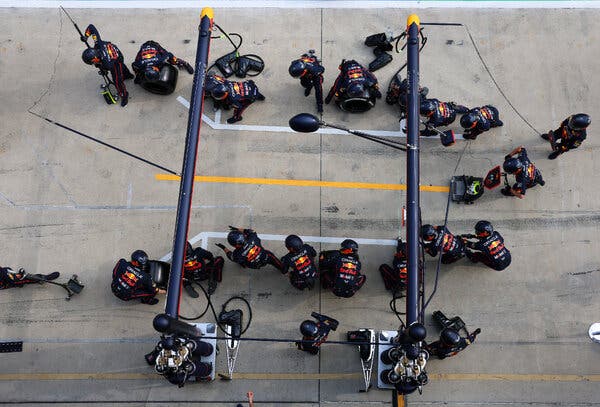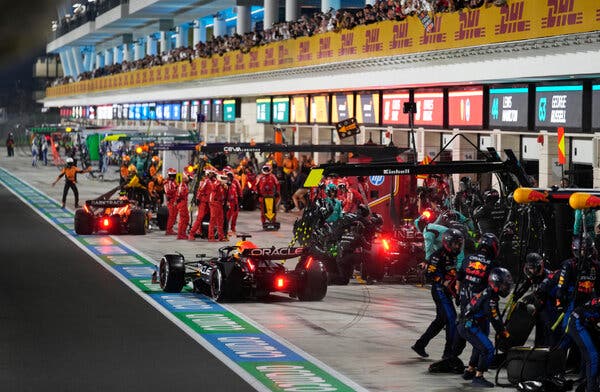In Formula 1 there are several critical junctures during a Grand Prix that influence its outcome.
One of those is what happens during pit stops, which, if done correctly, are a balletic display of engineering.
Regulations dictate that every driver must run two tire compounds during a Grand Prix, and that makes pit stops — at which all four tires must be changed — mandatory. Teams often must choose from the soft, medium and hard compounds offered by Pirelli, the tire supplier for the sport, and track conditions and the weather factor into which ones to use.
“You don’t win a race on a pit stop,” said Rich Wolverson, head of race team operations at Red Bull, “but you lose a race by having a bad pit stop.”
Red Bull was the fastest and most consistent pit-stop crew last season, with it and McLaren having the fastest individual pit time of 1.9 seconds.
Advertisement
SKIP ADVERTISEMENT
McLaren holds the record in Formula 1, at 1.8 seconds in the 2023 Qatar Grand Prix, but there is a balance to be struck.
“There’s a fine line between reliability and performance, getting that balance,” Wolverson said. “You don’t want to be pressuring everyone to get a world record every weekend because that’s where mistakes happen. You just want consistent stops that gives the driver confidence that he can maintain his position on the track.”
Formula 1: On and Off the Track
-
An Off-Season Full of Changes:Lewis Hamilton now drives for Ferrari, rookies are filling seats and Australia returns as the opening race.
-
Filling Big Shoes at Mercedes: Andrea Antonelli is the driver who is filling the seat left by Lewis Hamilton.
-
Race for This Year, or Next: With big rule changes coming for 2026, it will be hard to accomplish both. For many teams, it will be wait and see.
-
Expectations Are High: The year could turn into a free-for-all, with many teams and drivers expected to challenge for the titles.
-
More on Formula 1: Stories about drivers, teams and issues.
Red Bull targets an average pit-stop time of 2.2 seconds, which it regards as the trade-off between pursuing ultimate performance without risking a race-ruining mistake.
“You’ve got to be consistent,” Chris Gent, the team’s chief mechanic, said in an interview. “If you have a good one one time and then a bad one the next time, the strategy [team] have certain numbers, and if you’re missing those targets it’ll cost them for race strategy, so you need to be consistent in timings.”

Red Bull targets an average pit-stop time of 2.2 seconds. “You don’t win a race on a pit stop,” said Rich Wolverson, head of race team operations at Red Bull, “but you lose a race by having a bad pit stop.”Credit…Mark Thompson/Getty Images
Each team has a designated spot, called a box, in the pit lane. Hence the order to pit over a driver’s radio is “Box, box, box.” The box is usually slightly angled because it is faster and easier for drivers to brake from the pit lane speed limit of about 50 miles an hour at a shallower angle, and then accelerate out at a more acute slant.
Advertisement
SKIP ADVERTISEMENT
The pit stop usually involves around 22 people, with some as backups. Two hold the center of the car for stability while two more elevate the car on jacks. The front jack swivels sideways, speeding up the lowering process.
There are also three people per wheel, with one to remove the tire, which weighs around 22 pounds, one to affix the new tire and another to operate a device called the wheel gun. That removes the wheel nut on the first motion and puts the nut back on in the next motion.
A traffic light on a gantry above the driver — controlled by Gent — tells the driver when to go.
“There’s a lot of people,” Wolverson said, and getting each person to do their part perfectly “is very rare.”
Gent must be conscious of not only Red Bull’s pit stop, but also of other cars entering and exiting the pit lane. If any car is released into the path of another car it not only risks a collision, but will incur a five-second penalty.
Advertisement
SKIP ADVERTISEMENT
There will always be mistakes, including wheel gun failures, stuck wheel nuts and putting on the tires meant for a driver’s teammate, as well as loose wheels. Reacting rapidly to these setbacks is fundamental.
“It’s critical, because the next car could be coming in,” Wolverson said. “I can see what’s happening, and either it’s a technical or a human issue, because the control software has a fail-safe, so if it does fail-safe, the car will be stuck there. It’s quite time critical to work out what’s going on, the next car could be in the next lap, so you need to diagnose it, so if it’s wheel gun failure, you swap them and bring in the spare just in case.”

Each team has a designated spot, called a box, in the pit lane during a Formula 1 race.Credit…Altaf Qadri/Reuters
In 2021, Valtteri Bottas of Mercedes was forced to retire from the Monaco Grand Prix when a wheel nut was damaged and could not be removed during a pit stop. The car had to be sent to the factory with the tire still affixed before the nut was eventually sheared off. Technically, the pit stop took almost two days.
Pit-stop times have also evolved.
“I’ve been involved for 19 years,” Gent said, noting that the equipment has changed significantly. And since 2010, cars no longer refuel during races.
Advertisement
SKIP ADVERTISEMENT
“We used to be refueling, so you’re talking a 10-second pit stop, changing tires was no concern because you were always waiting on the fuel,” he said. “There were no quick release jacks, as you didn’t need them.”
Formula 1’s governing body, the F.I.A., regulates pit equipment to avoid costs spiraling, while teams are also conscious of where it’s best to spend their money to achieve the best results.
“Now we’ve reached a point where it’s plateaued in terms of the equipment,” Wolverson said of spending money on the equipment. “It’s within the cost cap now, so it’s balancing gains there versus what we’d spend on the car.”
That means that the 1.8-second record will be difficult to surpass.
“You try to go even quicker you’ll probably introduce errors, so I can’t see it getting much quicker, to be honest,” Gent said.
Early in the morning at Grands Prix, the sound of wheel guns is constant as teams practice pit stops, with the car being pushed slowly into the box for the awaiting mechanics. Teams also practice with older cars at their factories.
Advertisement
SKIP ADVERTISEMENT
“We probably do 30 stops across the race event in terms of practice, and live during the session, with a live car,” Wolverson said. That is particularly important at the start of each year to train any new mechanics.
“It’s about building their confidence with a live car,” Wolverson said. “We can do a lot in the factory, but nothing replicates the adrenaline of a live car coming towards you. We’ve only got a pool of people to choose from. We’ve got a group of mechanics, and we need to see who suits each role best.”